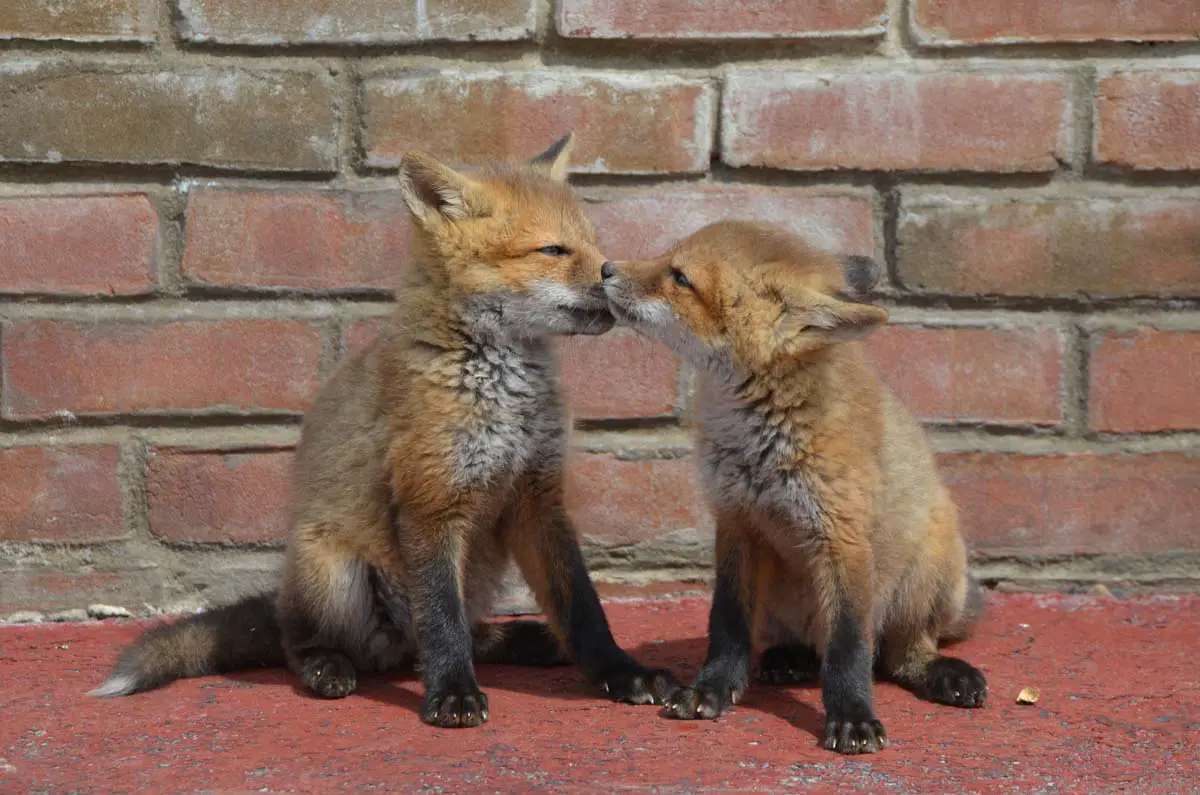Red foxes are one of the 12 true type fox species. They are the most widespread of all of the foxes, having a presence in many countries and regions. Let’s take a look at how red fox babies are born and how they survive!
Red fox babies are known as kits. The red fox is one of the most adaptable fox species in the world. Foxes are known to be great parents who take care of their young and provide them with the means and skills to survive in the wild.
Fox kits grow up fast and their time as youngsters is very limited. Luckily fox parents are great at raising their kits and making sure they are ready for the world.
Watch the Video
The average red fox only lives to be 2-3 years old in the wild. Much of what they learn as kits prepare them for their future, sometimes a fox might live past 3 and if they do they have usually seen and learned enough to live a few more years.
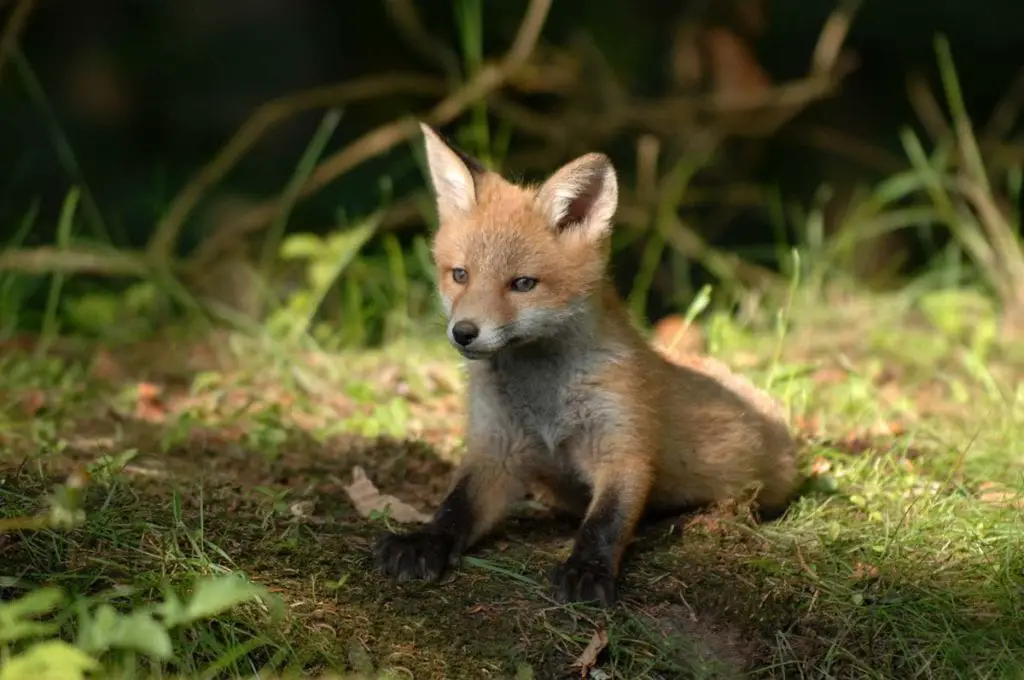
Red Foxes Mating
Mating season for red foxes usually starts in January. This is also when the red fox babies from the previous year (now adults) go out on their own, this time of year is also called dispersal season. The male yearlings are seen as a threat to the family because of food shortages and challenging other males.
The female yearlings may stick around to help with the raising of the new litter, while the males start their own journeys to find their way.
The male adult foxes are called dog foxes and the females are called vixens. It’s in January when the resident dog fox and vixen will start defending their territory and marking it with feces and urine, letting other foxes know that it’s their time to start a new litter.
They will also vocalize their actions by yelping, barking, and screeching through the night to warn off predators and send a message to foxes nearby to find a place of their own.
When mating the dog fox will insert itself into the vixen until they become locked together or “tied together” after a period of time the dog fox will release its semen into the vixen. They still do not come apart after and remain tied together as the dog fox begins to move his position they will sit locked together back against back for hours.
Foxes mate inside their dens and the dens are used primarily to raise their kits. Most foxes do not sleep in dens unless there is bad weather or they are mating. See more about different fox babies here.

Red Fox Gestation
Once the vixen is pregnant her gestation period starts. Red foxes have a short gestation period of only around 45-55 days. This is how long it takes after the female gets pregnant before the babies are born.
The females get pregnant sometime in January and have their cubs around 50 days later at the end of February or early March. At the beginning of February, the female begins to settle into the den where she prepares it to have her kits.
During the gestation period, the male fox will continue to mark its territory with feces and urine. They will oftentimes mark the perimeter of the den so that when the kit season starts other foxes already know to stay away.
The male will do most of the hunting bringing his kills back to the den for his pregnant vixen to feast on.
Vixens will also hunt during the early parts of gestation, doing their part to provide and keep food around the den.
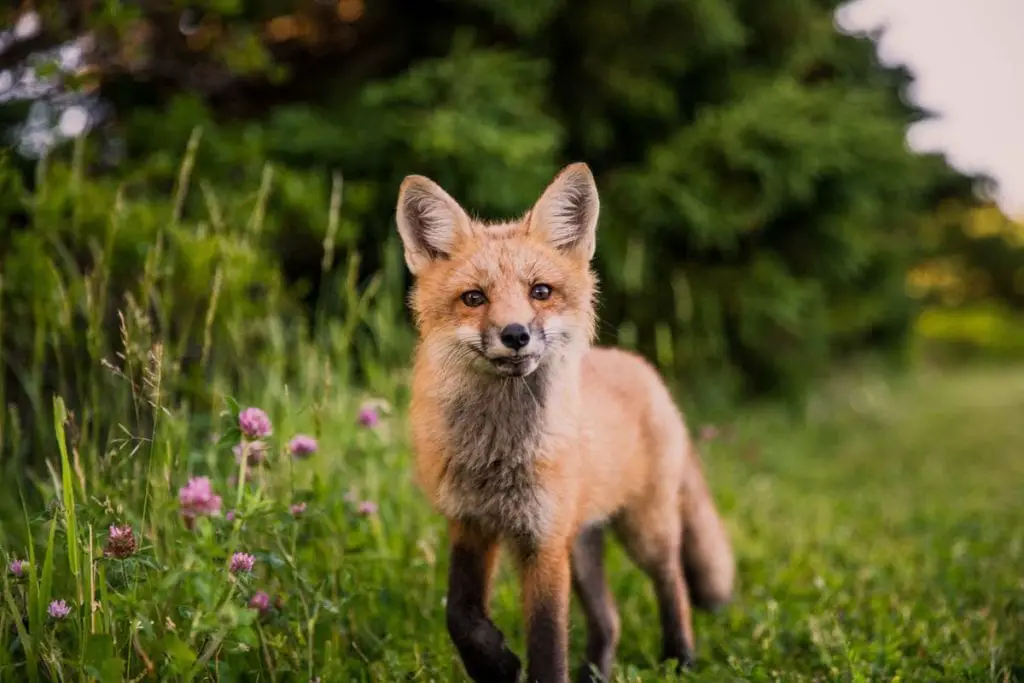
Foxes As Parents
Around early March, the kits are born. There are usually 5-8 kits per litter, the average being around 5. When baby foxes are born they are blind for 12-14 days. During this time the mother stays by their side.
The male fox must be vigilant in keeping predators away, baby foxes are susceptible to being carried off while their parents hunt, since they cannot see or defend themselves.
Foxes are good parents. They care a lot about their young and they do everything within their power to feed them and keep them safe. Red fox babies cannot regulate their temperature by panting so the mother will stay by their side to keep them warm.
They will stay huddled together so as not to get hypothermia and are inseparable at this point.
The mother also helps stimulate them by nudging them around so that they will have bowel movements and urinate.
Females from previous litters will sometimes stick around to help with this process as well as with hunting and securing the den. The male fox brings food to the den so the mother and the kits can feed.
The mother will regurgitate food into the mouths of the baby foxes. The baby foxes hydrate from absorbing what the mother provides them. If the dog fox does not come back to the den with food the vixen will go to the opening of the den and let out a number of fox calls, letting the dog fox know that they are ready to eat!

Red Fox Babies Coloration
The coloration of the baby foxes can vary, from being a dark color, a gray color, and a tan color. They usually have little dark legs and over a few weeks, they start to get their primary color.
They start with being a fine gray wool-like color with little pink noses, later their noses turn black. The babies weigh between 2-5 ounces. They are completely covered with short fur at this point.
Red foxes can be multiple colors, black, silver, red, or gold/tan. After about two weeks the fur changes from a dark grey to a warm brown color. Their colors start to morph.
They will go from the chocolate brown to their primary color in about 3 weeks’ time. This is also when they start to be able to see, getting the vertical pupils and walking around a small amount.
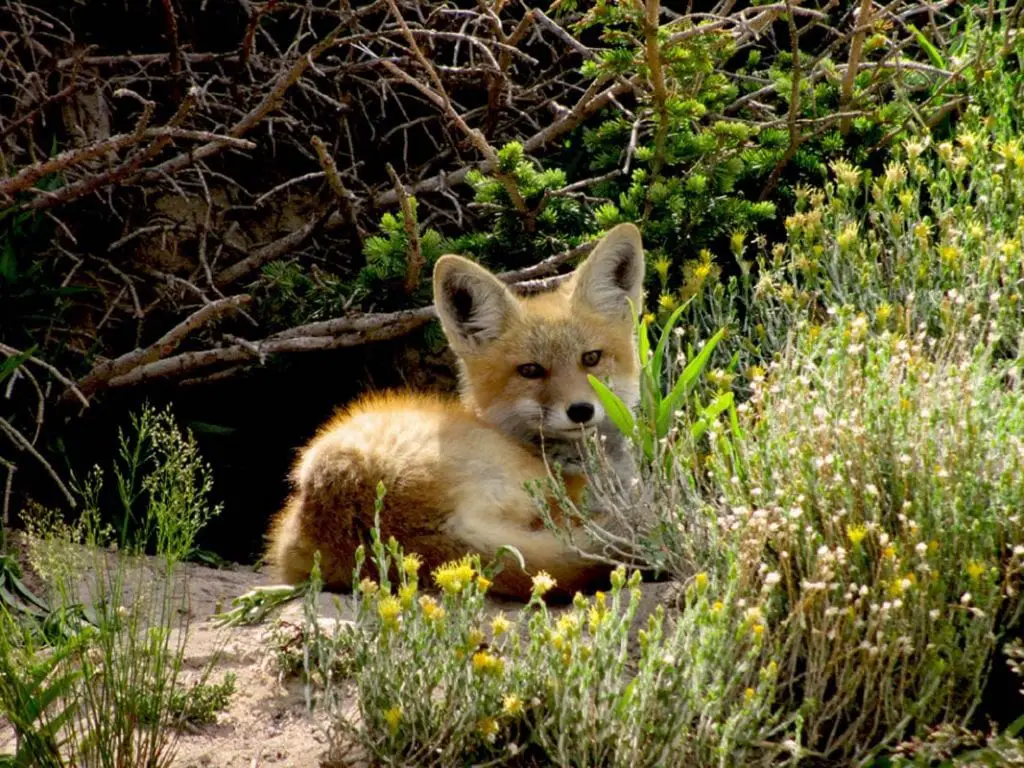
Babies In the Den
After those first few weeks, the kits begin to walk around a little, exercising their legs. The mother is still regurgitating their food at this point and only leaving their side to hunt or use the latrine. Foxes will use the same spot around the outside of the den to defecate, this is known as the latrine area.
The babies must be protected and fed for a time before they are allowed to start exploring the confines of the den. They will start to move around more once they get their vision.
This is also when the mother will start leaving small bits of food for them to try and chew, getting them ready to eat on their own. They stay huddled together when it is cold and do not venture far into the den at this point in time.
The dog fox does not sleep in the den, he sleeps outside in the underbrush or in a spot that has some cover. The female will also start sleeping outside at this time, now that the kits can thermoregulate themselves.
At this point any females from previous litters who stuck around go off on their own to start their own families and look for a mate.

Second Month
In the second month after the babies are born they start to venture closer to the den opening. The mother and father will leave carcasses in the opening so that the baby foxes can eat on their own and get familiar with the den.
The month is April at this point and now that the baby foxes are in their second month they know exactly how to feed themselves and start to poke their heads outside of the den.
Red fox babies are extremely curious and begin to lay outside of the den, curled up in a ball. The parents are usually close by guarding them against predators and napping when its safe.
In urban areas cats can be a problem for baby foxes, hearing them moving around in their dens, cats and even wild cats will attempt to kill them when no one is around, the way they do birds, mice, and small rabbits.
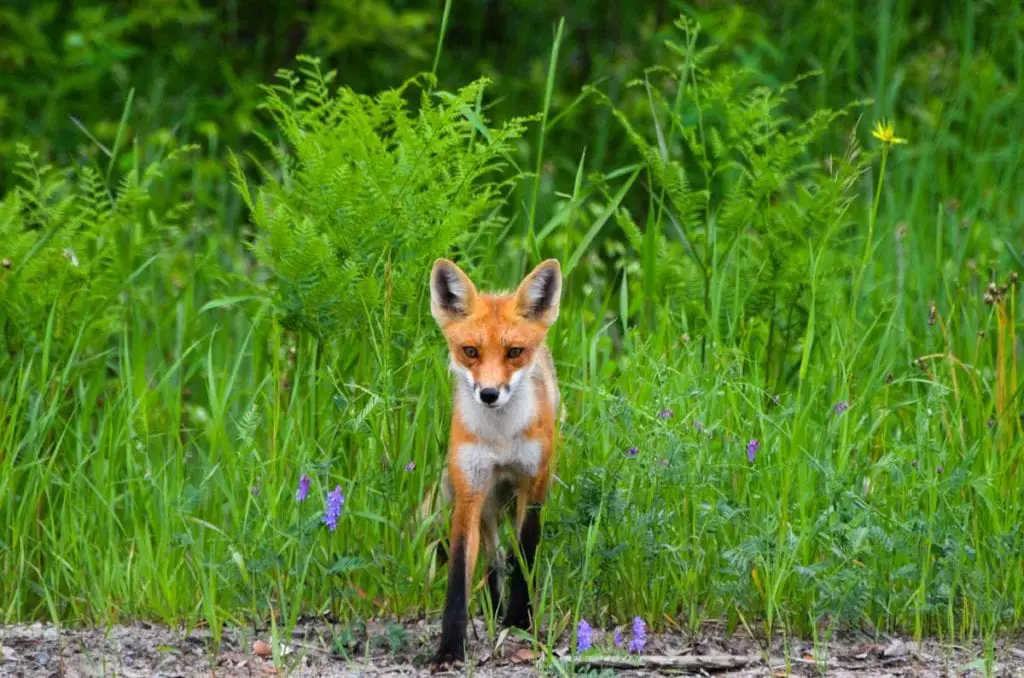
Learning The Ropes
All through April, the babies learn to feed themselves and that they must start doing things on their own. They “learn the ropes.” The dog fox and vixen still watch them closely, the dog fox will often stay close to the den to protect his family.
There are other predators that will prey on babies, such as eagles and badgers. Badgers will dig into the den when the parents are off hunting and attempt to get at the baby foxes.
When the baby foxes are outside of the den they can fall prey to large raptor birds such as eagles and owls, who will swoop down and carry them back to their nest for a meal.
At this point the babies are able to walk around and eat the carcasses that are left for them, their boundaries moving further away from the den. They still stay close to the den at this point and the parents will still keep a close eye on them.
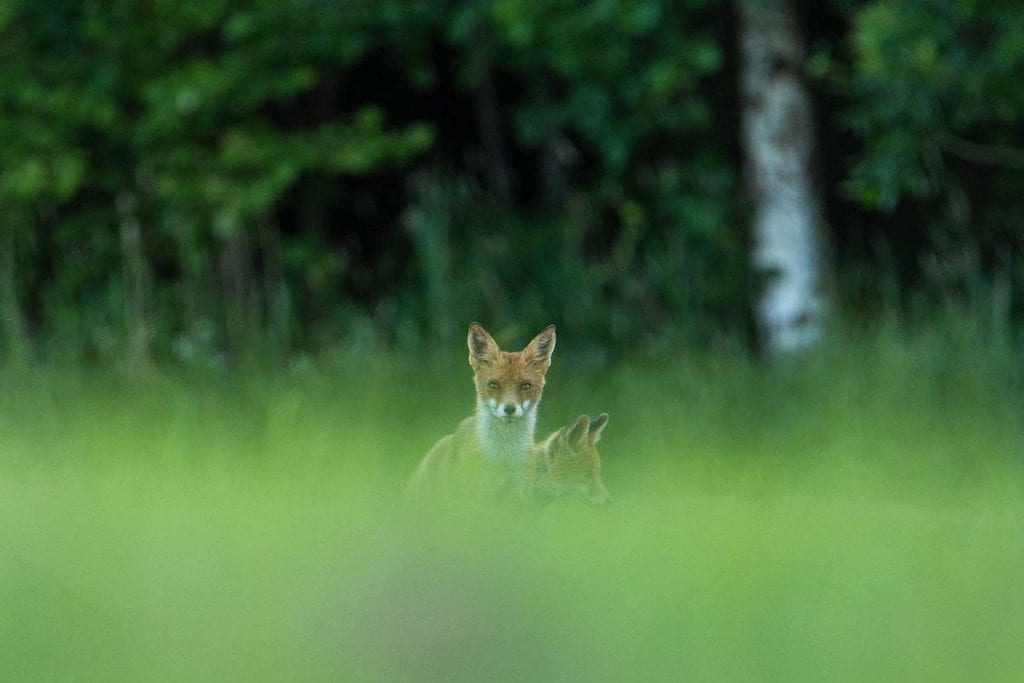
Fox Babies At Play
Red fox babies love to play! They will begin to growl and make noises at each other. They pile on top of each other and crash around the inside and outside of the den.
This playful period is when the babies start to learn the most important lessons, how to feed themselves, how to move around and jump. They also learn their place in the litter. There will often be a runt that falls behind and an alpha kit who hogs the food and eats first.
The mother also starts to hunt more and will wean the kits off of her milk. She will sleep outside of the den during the day and hunt at night.
After being weaned the cubs get a little stir crazy and slow down a little. They rely on the food the mother brings back to them and start to want more.
It’s usually around June when the kits begin to sleep and lie around the outside of the den until they abandon the den altogether and start sleeping in the brush around their territory.
Self Sufficient
In July the parents will bring less food for the kits and the kits will start making small kills, usually rodents and baby rabbits. It’s at this point that the kits start to become self-sufficient, learning that they must now fend for themselves.
They are around 4 months old at this point and in just a few more months the male kits will leave, finding their own territory and looking for mates.
They discover water sources and explore the home-range where they were born. They start getting more vocal, learning to communicate and also how to mark their territory, to communicate, this is called chemical communication.
Since foxes have such short gestation periods the life cycle of foxes is quick. They are able to start mating just after one-year-old.
The vixen and dog fox will split up the kits, the male fox taking half and the female taking the other to their hunting grounds. This is when the kits become efficient at hunting and fending for themselves.
Getting much larger and looking more like their parents the kits will start hunting for themselves, taking on the behavior of their parents, hunting at night and sleeping during the day.
They are much stronger at this point and have developed their skills for hunting and surviving going into the month of August.
They will also start to forage at night, splitting into groups of two to find berries and other vegetation. This is evident from the seeds and purple color of their fox poop.

Off Into The World
Now, during the month of September and through December, the kits are almost full-grown, and can hardly be told apart from their parents. They are almost ready to leave off on their own.
At this point the young foxes have mastered their vocals, knowing how to communicate with their fox calls and give different signals with their tails. This helps them once they disperse so that they can communicate with other foxes they come across.
The female kits have a tendency to not want to leave and will hang around much longer than the males. The male kits will now be going out for much longer hunting trips in the night and returning with their own kills, that they will bury and eat from multiple times.
They are now adept hunters and are ready for the world. The males start to disperse in December/January in search of their own home-range and a mate. The females will sometimes wait until late longer to leave, or one will decide to hang around and help with next year’s litter.
From there the process continues with the red fox babies becoming parents themselves starting their own families and building their own dens to nurture and teach their young.
Foxes are smart creatures and learn fast that they must adapt to survive in the wild. Nature has a way of being cruel sometimes, which is why many foxes never see past 3 years old.
However, foxes in captivity live to be much older and red foxes as pets can live up to 14 years with the right care and in the right conditions.
Check out our PAWSOME new collection of Fox Gifts
Related Questions
Why are baby foxes blind? Baby foxes like many other animals are born blind and have very sensitive eyes. They remain shut for almost two full weeks until they are able to open and let small amounts of light in. This is the same with puppies and kittens. After a few weeks, their eyes start to adjust and they get their full sight.
Do red fox babies ever get abandoned? Fox parents are usually pretty good about keeping up with their babies, however, it does happen sometimes during bad weather and times when they move from den to den, that a fox baby may get left behind. If this happens they will most likely not survive, either starving or falling prey to a predator.

